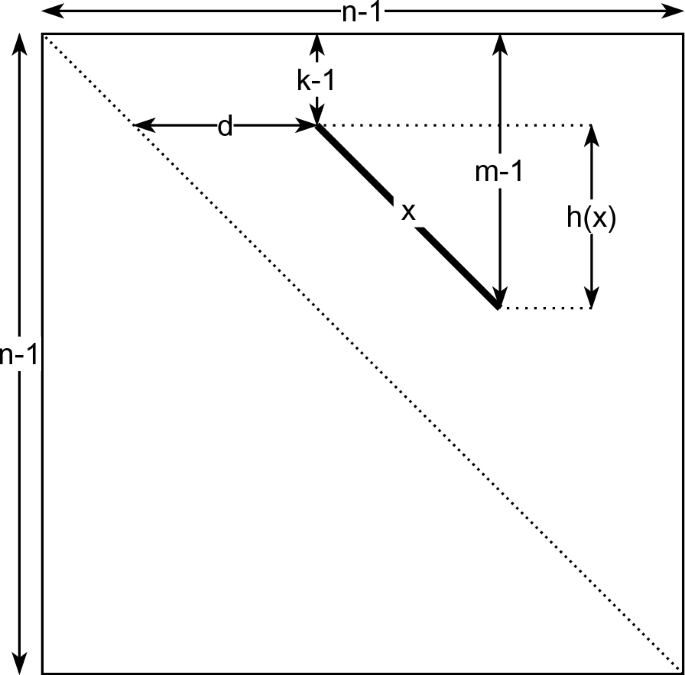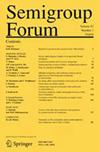“白嘴鸦单群的一个子半群”的推广
IF 0.7
3区 数学
Q2 MATHEMATICS
引用次数: 0
摘要
摘要本文研究了车单阵的一个逆子单阵$$M_{n}$$ mn,通过若干属于$${\mathbb {Z}}^3$$ z3的三元组来表示$$M_{n}$$ mn的非零元素。在本文中,我们允许三元组属于$${\mathbb {R}}^3$$ r3。因此,我们研究了一个新的逆单阵$$\overline{M}_{n}$$ M¯n,它是$$M_{n}$$ M n的超单阵。我们指出相似之处,找出本质的不同之处。我们证明$$\overline{M}_{n}$$ M¯n是一个非交换的、周期的、组合的、基本的、完全半简单的、强的$${E}^{*}$$ E * -酉逆单群。本文章由计算机程序翻译,如有差异,请以英文原文为准。

An extension to “A subsemigroup of the rook monoid”
Abstract A recent paper studied an inverse submonoid $$M_{n}$$ M n of the rook monoid, by representing the nonzero elements of $$M_{n}$$ M n via certain triplets belonging to $${\mathbb {Z}}^3$$ Z 3 . In this note, we allow the triplets to belong to $${\mathbb {R}}^3$$ R 3 . We thus study a new inverse monoid $$\overline{M}_{n}$$ M ¯ n , which is a supermonoid of $$M_{n}$$ M n . We point out similarities and find essential differences. We show that $$\overline{M}_{n}$$ M ¯ n is a noncommutative, periodic, combinatorial, fundamental, completely semisimple, and strongly $${E}^{*}$$ E ∗ -unitary inverse monoid.
求助全文
通过发布文献求助,成功后即可免费获取论文全文。
去求助
来源期刊

Semigroup Forum
数学-数学
CiteScore
1.50
自引率
14.30%
发文量
79
审稿时长
12 months
期刊介绍:
Semigroup Forum is a platform for speedy and efficient transmission of information on current research in semigroup theory.
Scope: Algebraic semigroups, topological semigroups, partially ordered semigroups, semigroups of measures and harmonic analysis on semigroups, numerical semigroups, transformation semigroups, semigroups of operators, and applications of semigroup theory to other disciplines such as ring theory, category theory, automata, logic, etc.
Languages: English (preferred), French, German, Russian.
Survey Articles: Expository, such as a symposium lecture. Of any length. May include original work, but should present the nonspecialist with a reasonably elementary and self-contained account of the fundamental parts of the subject.
Research Articles: Will be subject to the usual refereeing procedure.
Research Announcements: Description, limited to eight pages, of new results, mostly without proofs, of full length papers appearing elsewhere. The announcement must be accompanied by a copy of the unabridged version.
Short Notes: (Maximum 4 pages) Worthy of the readers'' attention, such as new proofs, significant generalizations of known facts, comments on unsolved problems, historical remarks, etc.
Research Problems: Unsolved research problems.
Announcements: Of conferences, seminars, and symposia on Semigroup Theory.
Abstracts and Bibliographical Items: Abstracts in English, limited to one page, of completed work are solicited.
Listings of books, papers, and lecture notes previously published elsewhere and, above all, of new papers for which preprints are available are solicited from all authors.
Abstracts for Reviewing Journals: Authors are invited to provide with their manuscript informally a one-page abstract of their contribution with key words and phrases and with subject matter classification. This material will be forwarded to Zentralblatt für Mathematik.
 求助内容:
求助内容: 应助结果提醒方式:
应助结果提醒方式:


